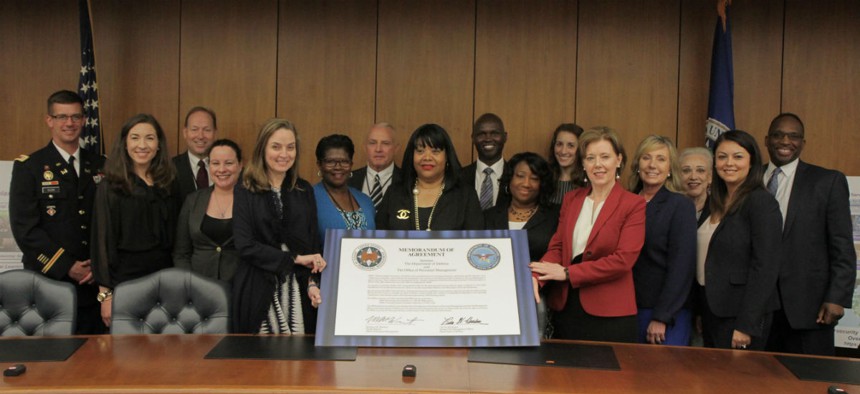Shifting the Pentagon’s Employee Training to OPM Could Save Millions

Officials at the signing of a memorandum of understanding between the Office of Personnel Management and the Defense Department May 3. OPM
The move also establishes the Defense Department as a petri dish for OPM to obtain more data on how employees learn and where more training is needed.
With the stroke of a pen Friday, federal officials shifted responsibility for managing the Defense Department’s skills training courses to the Office of Personnel Management’s USALearning platform.
The move—intended to reduce costs and streamline annual and career development training for the military—will mean big changes on the backend and, potentially, provide a more comprehensive training regimen for employees without causing too much disruption.
“The President’s Management Agenda has prioritized three areas of reform: IT modernization, data transparency and accountability and workforce of the 21st century,” Defense Department’s acting Chief Management Officer Lisa Hershman said during a signing ceremony and media roundtable Friday. “This reform initiative is one of those rare initiatives that addresses all three.”
The department currently has some 50,000 learning courses spread across 161 separate platforms, on which Defense employees spend more than 300 labor hours each year, Hershman said.
“Moving to USALearning platform will reduce the redundancy in learning courses and allow us to move to a DOD-wide common course catalog,” she said. “This is a pivotal step in becoming easier to do business with.”
Hershman noted those efforts are usually outward facing—to the public or industrial base working with the department. In this instance, however, it’s about serving their internal customers: the employees.
“This is one that will greatly reduce the complexity for our employees,” she said. “In this instance, our employees are our customer. And the No. 1 thing in the U.S. in terms of driving a positive experience is simplicity.”
While the backend technical systems—the servers, platforms and websites—will now be managed by OPM, the look and feel of the frontend web portals will remain as they are, with little change for the end users.
“The intent is to have it invisible to the user,” said William Peratino, OPM deputy director for new and emerging human resources technologies. “Every one of our users—whether on the federal or DOD side—have their own branding, their own look and feel, and their own culture that they want to emulate. So, we don’t disrupt that.”
Acting OPM Director Margaret Weichert described the relationship as providing a “white label” service, created by OPM but tailored by the Defense Department to feel local and customized.
“We have a common core course and every USALearning customer now gets five standard courses: your managerial courses, sexual harassment, government ethics, etc.,” Peratino said. “Every agency gets the very same core courses but we skin it and customize and brand it for that agency, that way we’ve eliminated all that duplication of development effort.”
Users will see changes in the kinds of courses offered and how they are grouped into “competencies” that can be verified and translated across the Defense Department, civilian government and even the private sector.
“One of the first things that we’re doing is we’re distilling things down to competencies because competencies are universal across the enterprise,” Peratino said. “Then, we can create that common course catalog, have the content correlated across competencies, so when people are doing a job search—whether they want to progress in their current job or they want to transition somewhere else—they can then assess their competency level where they are, get information on what they need to do to achieve the next level of proficiency through those competencies and then be competitive for their next job or opportunity.”
Beyond the customer experience angle, the shift is expected to lead to cost savings of up to $22 million in 2020 and $122 million over the next five years, Hershman said, as well as generate extremely helpful training data that can be used across government.
“This partnership is obviously going to benefit DOD. But it benefits the broader government environment, as well—leverages this shared infrastructure and it leverages data—and this is really important,” Weichert said.
As the largest single organization within government, the Defense Department offers a unique opportunity for OPM to obtain diverse data on how effective these training courses are for employees, what new courses are needed and more.
“The learnings we’re going to get here will enable us to do more for the rest of government at scale,” Weichert said. “It’s a really tremendous thing.”
“Having a population as large as DOD, having consistency, and then having data behind the scenes will do so much for learning how people learn,” she said.
All of that will inform how feds learn in the future.
“This isn’t about just technology. It’s not just about good contracting or acquisition strategies,” Peratino said. “This is about adult learning. The science behind adult learning—all the research behind that—that’s what we bring to bear.”
“I like to say it’s a three-legged stool that we have at USALearning that doesn’t exist anywhere else in government: We have a unique acquisition strategy; we have a unique business model; and we have over 80 years of domain expertise within the staff. That doesn’t exist anywhere else in government, I believe,” he added.






